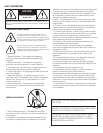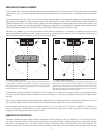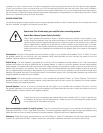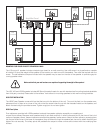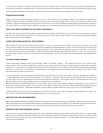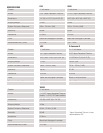6
If your oor is not rigid, the spikes may actually add to the rocking motion, so we recommend you audition the speakers with
and without the spikes inserted to see if you discover a personal preference in the sound quality. Be especially careful when
moving speaker cabinets with the spikes attached, as the points could damage carpeting or scratch oors.
V5520 FOOT INSTALLATION
Apply two of the provided adhesive bumpers to the two front corners of the speaker. Insert one of the two supplied 6mm
Phillips screws through the recessed hole of the plastic legs and screw the legs to the bottom of the speaker cabinet insert
locations. Adjust the angled end of the leg so it will set level on your shelf or tabletop before tightening the screws completely.
For vertical placement, apply the four adhesive bumpers to one end of the speaker, placing them at the corners of the cabinet.
TABLE TOP OR SHELF PLACEMENT (V52, V62, V5520, V-SURROUND-II)
Included with your Phase Velocity speaker are self adhesive bumpers that can be used on the bottom of the speaker to protect
the nish and surface when placing it on a shelf or table top. Simply peel off the bumpers from the backing paper and apply
them to the bottom of the speaker.
STEREO (TWO CHANNEL) OPERATION - FIRST LISTENING
Play a stereo CD that contains a strong solo vocalist. Sit at your normal listening position and listen to the singer. If the artist
sounds “center stage” with music coming between the speakers, the speakers are in phase. On the other hand, if vocals sound
as if they are coming from the two sides or are not focused in the central area, the speakers may be out of phase. In this event,
turn off the power, unplug your amplier or receiver and check that the leads are hooked up correctly. Then, turn everything on
and listen again. When the sound is natural and the soloist appears to be in the middle of the sound stage, the speakers are in
phase.
Two-Channel Speaker Placement
Phase Technology speakers utilize our Absolute Phase™ crossover network. This design permits a much wider vertical
output pattern than conventional speakers, allowing you to achieve the best quality musical experience regardless of speaker
placement. For example, your speakers can be placed either vertically or horizontally on a bookshelf and will provide seamless
transition of sound from one speaker to another even if the speakers cannot be placed at the traditional “ear level” height
recommended by most manufacturers.
In most rectangular rooms speakers sound best when placed along one of the short walls. Begin by placing the speakers 1
– 3 feet away from the wall and approximately 6 – 8 feet apart. The exact nal placement will be determined by how far away
you are sitting from the speakers and other interior environmental factors. We suggest playing a familiar piece of music and
adjusting the placement of the speakers until the desired sound is achieved.
Sometimes larger bookshelf speakers will sound better when placed upon stands designed expressly for the purpose of
supporting them above oor level. By “de-coupling” the speaker cabinet from the oor, bass frequencies are tighter and high
frequencies more distinct. Stands are available in a wide variety of types, sizes and price ranges from your local retailer.
Smaller speakers can be placed in bookshelves or cabinets; however, some loss of imaging may be experienced. Again, only
trial and error will determine the best possible result for your circumstances.
AMPLIFIER SETUP AND BASS MANAGEMENT
Many home theater receivers/processors have a feature that controls how the bass is processed and delivered to the subwoofer.
It also adjusts the amount of bass that is sent to your satellite speakers. Look carefully in your amplier or receiver’s instruction
manual for details on how to adjust for the speaker size (sometimes called “Speaker Setup”) for your system.
CARING FOR YOUR PHASE TECHNOLOGY SPEAKER
All Phase Technology speakers are nished with a high degree of craftsmanship in either hand polished paint or vinyl laminates.
We recommend using a lint-free rag with a small amount of glass cleaner to maintain the long-lasting beauty of the nish. Avoid
products containing silicones, oils, oil derivatives, or solvents. Enclosures nished in vinyl laminates may be cleaned with a
damp cloth as necessary.




